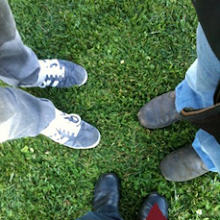 A frieze of horses and rhinos near the Chauvet cave’s Megaloceros Gallery,
A frieze of horses and rhinos near the Chauvet cave’s Megaloceros Gallery, where artists may have gathered to make charcoal for drawing.
The earliest known cave paintings were created perhaps 32, 000 years ago.
from at least thirty-two thousand years ago.
THE NEW YORKER, June 23, 2008
Letter from Southern France, by Judith Thurman
Letter from Southern France, by Judith Thurman
"What does the world's oldest art say about us?"
During the Old Stone Age, between 37,000 and 11,000 years ago, some of the most remarkable art ever conceived was etched or painted on the walls of caves in southern France and northern Spain.
Picasso reportedly said to his guide, after a visit to Lascaux,
“They’ve invented everything.”
What those first artists invented was a language of signs for which there will never be a Rosetta stone; perspective, a technique that was not rediscovered until the Athenian Golden Age; and a bestiary of such vitality and finesse that, by the flicker of torchlight, the animals seem to surge from the walls, and move across them like figures in a magic lantern show (in that sense, the artists invented animation).
...
They also thought up the grease lamp—a lump of fat, with a plant wick, placed in a hollow stone—to light their workplace; scaffolds to reach high places; the principles of stencilling and Pointillism; powdered colors, brushes, and stumping cloths; and, more to the point of Picasso’s insight, the very concept of an image.
...
A true artist reimagines that concept with every blank canvas—but not from a void.
...
Thurman goes on to "explore" the caves' paintings' techniques, history, meanings, and impressions. A powerful article from the New Yorker's archives.
I've always wanted to go see; now the need is intense.
...
I'm hoping for T's plantar fasciaitis to heal soon, so we can get moving, literally. I must feed this traveling bug.
......

No comments:
Post a Comment